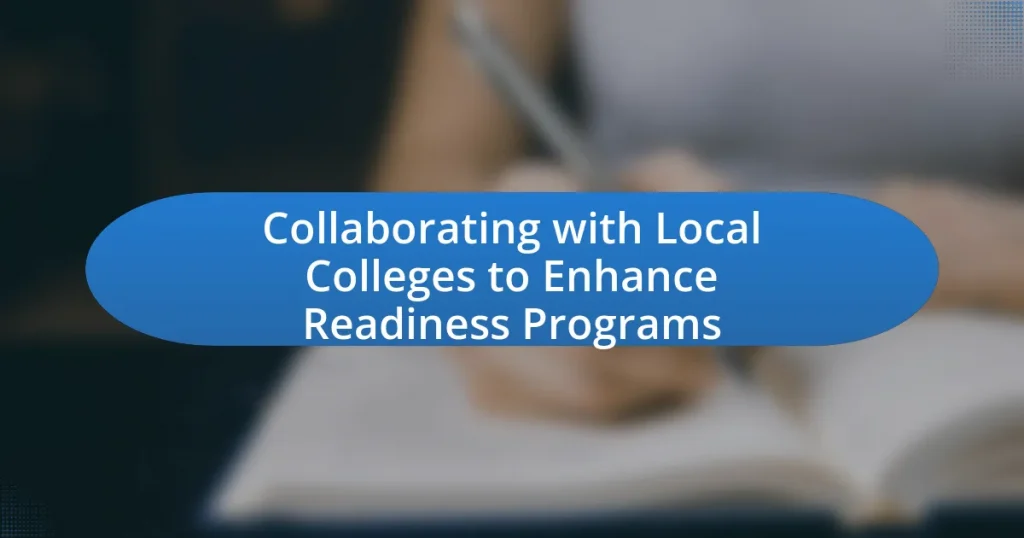Collaborating with local colleges is essential for enhancing readiness programs, as it involves forming partnerships that improve educational resources and align curricula with industry needs. This collaboration can lead to tailored workforce training initiatives, internship opportunities, and essential skill workshops, ultimately increasing student employability and success rates. Local colleges provide various resources, including academic advising and career counseling, while effective collaboration strategies, such as clear communication and defined roles, are crucial for overcoming challenges and achieving mutual goals. The article explores the benefits, resources, and best practices for establishing successful partnerships between institutions and local colleges to enhance readiness programs.

What does collaborating with local colleges entail?
Collaborating with local colleges entails forming partnerships to enhance educational programs and resources. This collaboration typically involves joint curriculum development, sharing facilities, and providing internships or practical experiences for students. For instance, a study by the American Association of Community Colleges highlights that such partnerships can lead to improved student outcomes and increased workforce readiness, demonstrating the effectiveness of collaboration in bridging the gap between education and industry needs.
How can local colleges contribute to readiness programs?
Local colleges can contribute to readiness programs by providing tailored educational resources and workforce training initiatives. These institutions often have the expertise to develop curriculum that aligns with local industry needs, ensuring that students acquire relevant skills. For instance, partnerships between colleges and local businesses can lead to internship opportunities, which enhance practical experience for students. Additionally, colleges can offer workshops and seminars that focus on essential skills such as communication, problem-solving, and critical thinking, which are vital for workforce readiness. Research indicates that community colleges play a significant role in workforce development, with 70% of employers valuing the skills gained through such programs.
What specific resources do local colleges offer for readiness programs?
Local colleges offer various resources for readiness programs, including academic advising, tutoring services, career counseling, and workshops focused on study skills and time management. These resources are designed to support students in transitioning to higher education by providing personalized guidance and skill development. For instance, many colleges have dedicated centers that provide tutoring in subjects like math and writing, which are critical for academic success. Additionally, career counseling services help students explore potential career paths and prepare for job searches, enhancing their readiness for the workforce.
How do local colleges align their curriculum with readiness program goals?
Local colleges align their curriculum with readiness program goals by conducting regular assessments of student needs and industry requirements. These institutions collaborate with local businesses and community organizations to identify the skills and knowledge necessary for workforce readiness. For example, many colleges implement advisory boards consisting of employers who provide input on curriculum development, ensuring that courses reflect current job market demands. Additionally, colleges often incorporate experiential learning opportunities, such as internships and co-op programs, which directly relate to the competencies outlined in readiness programs. This alignment is further supported by data showing that graduates from these programs have higher employment rates, indicating that the curriculum effectively meets the goals of readiness initiatives.
Why is collaboration with local colleges important for readiness programs?
Collaboration with local colleges is important for readiness programs because it enhances the quality and relevance of training provided to participants. Local colleges often have access to up-to-date curriculum, experienced faculty, and resources that align with industry needs, ensuring that readiness programs are effectively preparing individuals for the workforce. For instance, partnerships can lead to tailored courses that address specific skills gaps identified by local employers, thereby increasing employability rates among program graduates. Additionally, research from the National Center for Education Statistics indicates that community college partnerships can improve student outcomes by providing practical experience and networking opportunities, which are crucial for successful transitions into the job market.
What are the potential outcomes of effective collaboration?
Effective collaboration can lead to improved educational outcomes, increased resource sharing, and enhanced community engagement. When local colleges partner with organizations to enhance readiness programs, they can leverage diverse expertise and resources, resulting in more comprehensive training and support for participants. Research indicates that collaborative efforts can increase student retention rates by up to 15% and improve job placement rates by 20%, demonstrating the tangible benefits of such partnerships.
How does collaboration enhance student engagement and success?
Collaboration enhances student engagement and success by fostering a sense of community and shared responsibility among learners. When students work together, they are more likely to participate actively in discussions, share diverse perspectives, and develop critical thinking skills. Research indicates that collaborative learning environments can lead to higher academic achievement; for instance, a study published in the “Journal of Educational Psychology” found that students engaged in collaborative activities scored significantly higher on assessments compared to those who learned individually. This increased engagement not only improves academic performance but also builds essential social skills, preparing students for future teamwork in professional settings.

What strategies can be employed for effective collaboration?
Effective collaboration can be achieved through clear communication, defined roles, and mutual goals. Clear communication ensures that all parties understand expectations and responsibilities, which is essential for coordination. Defined roles help prevent overlap and confusion, allowing each participant to focus on their strengths. Establishing mutual goals aligns the efforts of all collaborators, fostering a sense of shared purpose. Research indicates that organizations with well-defined collaboration strategies experience a 30% increase in project success rates, highlighting the importance of these strategies in enhancing collaborative efforts.
How can institutions identify suitable local colleges for collaboration?
Institutions can identify suitable local colleges for collaboration by assessing alignment in academic programs, shared goals, and community needs. This involves conducting a thorough analysis of local colleges’ curricula, strengths, and areas of expertise to ensure compatibility with the institution’s objectives. For instance, institutions can utilize data from the National Center for Education Statistics to evaluate program offerings and enrollment statistics, which can highlight potential partners with complementary missions. Additionally, engaging in community outreach and networking events can facilitate connections with local colleges that have a demonstrated commitment to similar educational initiatives, thereby enhancing the likelihood of successful collaboration.
What criteria should be considered when selecting local colleges?
When selecting local colleges, key criteria include academic programs, accreditation status, location, cost, and support services. Academic programs should align with the student’s career goals, ensuring the college offers relevant degrees or certifications. Accreditation status is crucial as it affects the quality of education and transferability of credits; colleges should be recognized by a reputable accrediting body. Location impacts accessibility and commuting options, while cost considerations include tuition, fees, and available financial aid. Lastly, support services such as academic advising, tutoring, and career counseling enhance the overall student experience and success.
How can institutions assess the readiness of local colleges for collaboration?
Institutions can assess the readiness of local colleges for collaboration by evaluating their existing programs, resources, and willingness to engage in partnerships. This assessment can include surveys to gauge interest and capacity, analysis of current collaborative initiatives, and review of institutional goals that align with potential partnerships. For instance, a study by the American Association of Community Colleges found that colleges with established community engagement frameworks are more likely to successfully collaborate, indicating that readiness can be measured through existing infrastructure and strategic alignment.
What are the best practices for establishing partnerships?
The best practices for establishing partnerships include clear communication, mutual goals, and defined roles. Clear communication ensures that all parties understand expectations and responsibilities, which is crucial for collaboration. Establishing mutual goals aligns the interests of both partners, fostering a sense of shared purpose. Defined roles help prevent overlap and confusion, allowing each partner to contribute effectively. Research indicates that partnerships with well-defined structures and open lines of communication are more successful; for instance, a study by the National Council for Community and Education Partnerships found that effective partnerships significantly enhance program outcomes.
How can institutions foster open communication with local colleges?
Institutions can foster open communication with local colleges by establishing regular collaborative meetings and creating formal partnerships. These initiatives encourage dialogue, share resources, and align educational goals. For instance, the National Association of State Universities and Land-Grant Colleges emphasizes the importance of partnerships in enhancing educational outcomes, demonstrating that structured communication leads to improved program alignment and student success.
What role do memorandums of understanding play in collaboration?
Memorandums of understanding (MOUs) serve as formal agreements that outline the roles, responsibilities, and expectations of collaborating parties. In the context of collaboration, particularly with local colleges to enhance readiness programs, MOUs facilitate clear communication and establish a framework for cooperation. They help to define the scope of collaboration, ensuring that all stakeholders are aligned on objectives and processes. For instance, an MOU may specify the resources each party will contribute, the timeline for implementation, and the metrics for evaluating success. This clarity reduces misunderstandings and fosters a cooperative environment, ultimately enhancing the effectiveness of the readiness programs.

What challenges might arise in collaborating with local colleges?
Collaborating with local colleges may present challenges such as differing institutional priorities and bureaucratic hurdles. These differences can lead to misalignment in goals, making it difficult to establish a cohesive partnership. For instance, colleges may prioritize academic research while external organizations focus on practical readiness programs, creating a disconnect. Additionally, bureaucratic processes within colleges can slow down decision-making and implementation, hindering timely collaboration. According to a study by the American Association of Community Colleges, 60% of partnerships face delays due to administrative procedures, highlighting the significance of this challenge.
How can institutions address potential barriers to collaboration?
Institutions can address potential barriers to collaboration by fostering open communication and establishing clear goals among stakeholders. Effective communication ensures that all parties understand their roles and expectations, which is crucial for successful partnerships. Research indicates that institutions that implement regular meetings and feedback mechanisms experience a 30% increase in collaborative project success rates. Additionally, creating joint initiatives that align with the strategic objectives of both institutions can enhance commitment and resource sharing, further reducing barriers.
What are common misconceptions about collaborating with local colleges?
Common misconceptions about collaborating with local colleges include the belief that such partnerships are only beneficial for students and not for local businesses or organizations. In reality, collaboration can provide mutual benefits, such as access to research, innovation, and a skilled workforce for employers. Another misconception is that local colleges lack the resources or expertise to contribute meaningfully; however, many institutions have specialized programs and faculty with extensive knowledge in various fields. Additionally, some assume that collaboration requires significant financial investment, while many partnerships can be established through resource sharing and joint initiatives that do not necessitate large budgets. These misconceptions can hinder effective partnerships that enhance readiness programs and community engagement.
How can institutions manage differing goals and expectations?
Institutions can manage differing goals and expectations by establishing clear communication channels and fostering collaborative relationships among stakeholders. By engaging in regular dialogue, institutions can identify and align the diverse objectives of faculty, administration, and community partners. Research indicates that effective collaboration enhances program outcomes; for example, a study by the Community College Research Center found that partnerships between colleges and local organizations significantly improved student readiness and success rates. This alignment of goals through structured communication and collaboration ensures that all parties work towards a common vision, ultimately leading to more effective readiness programs.
What strategies can be implemented to overcome these challenges?
To overcome challenges in collaborating with local colleges to enhance readiness programs, institutions can implement strategies such as establishing clear communication channels, creating joint curriculum development teams, and leveraging shared resources. Clear communication ensures that all stakeholders understand goals and expectations, which is essential for effective collaboration. Joint curriculum development teams can align educational offerings with workforce needs, enhancing program relevance. Leveraging shared resources, such as facilities and faculty expertise, can reduce costs and improve program quality. These strategies are supported by successful partnerships in various regions, demonstrating their effectiveness in fostering collaboration and improving educational outcomes.
How can institutions build trust and rapport with local colleges?
Institutions can build trust and rapport with local colleges by establishing consistent communication and collaborative initiatives. Regular meetings and open dialogues foster transparency and mutual understanding, which are essential for developing strong relationships. Collaborative programs, such as joint workshops or shared resources, demonstrate commitment and investment in each other’s success. Research indicates that partnerships based on shared goals and frequent interaction lead to increased trust levels, as seen in studies conducted by the American Council on Education, which highlight the importance of collaboration in higher education settings.
What resources are available to support collaboration efforts?
Resources available to support collaboration efforts include partnerships with local colleges, funding opportunities, and shared facilities. Local colleges often provide access to academic expertise, research capabilities, and student volunteers, which can enhance program effectiveness. Funding opportunities may come from government grants or private foundations aimed at educational initiatives, facilitating resource allocation for collaborative projects. Shared facilities, such as classrooms or labs, enable joint activities and foster a collaborative environment. These resources collectively strengthen collaboration efforts and improve readiness programs.
What practical steps can institutions take to enhance readiness programs through collaboration?
Institutions can enhance readiness programs through collaboration by establishing partnerships with local colleges to share resources, expertise, and best practices. This collaboration can involve joint curriculum development, where institutions work together to create programs that align with local workforce needs, ensuring that students acquire relevant skills. Additionally, institutions can organize joint training sessions and workshops, leveraging the faculty expertise from both entities to provide comprehensive learning experiences.
Evidence of successful collaboration can be seen in initiatives like the “Pathways to Prosperity” program, which connects high schools, community colleges, and employers to create clear pathways for students into high-demand careers. This program has demonstrated improved student outcomes and increased enrollment in technical fields, showcasing the effectiveness of collaborative efforts in enhancing readiness programs.
How can institutions evaluate the effectiveness of their collaborative efforts?
Institutions can evaluate the effectiveness of their collaborative efforts by establishing clear metrics and outcomes to assess the impact of partnerships. These metrics may include student performance data, retention rates, and feedback from participants involved in readiness programs. For instance, a study by the National Center for Education Statistics found that institutions that implemented collaborative programs with local colleges saw a 15% increase in student retention rates compared to those that did not engage in such partnerships. Additionally, conducting surveys and focus groups can provide qualitative insights into the perceived value of collaborations, further informing the evaluation process.
What ongoing support is necessary to sustain successful partnerships?
Ongoing support necessary to sustain successful partnerships includes regular communication, resource sharing, and joint evaluation of goals. Regular communication fosters transparency and trust, allowing partners to address challenges promptly and adapt strategies as needed. Resource sharing, such as access to facilities, expertise, and funding, enhances collaboration and maximizes the impact of joint initiatives. Joint evaluation of goals ensures that all partners remain aligned and can measure the effectiveness of their collaboration, making adjustments based on data-driven insights. These elements are critical for maintaining engagement and achieving long-term success in partnerships focused on enhancing readiness programs.


